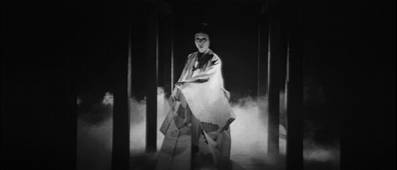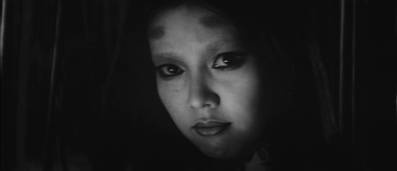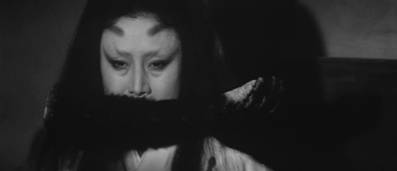|
It's
easy to forget, as Shindo Kaneto's Kuroneko (The Black Cat, full title Yaba
no naka no kuroneko, or The Black Cat From
Inside the Bamboo Grove) opens on a
scope-framed monochrome wide shot of samurai-era farmland – a familiar
location from late 50s and early 60s Kurosawa and the early Zatoichi films – that the film was actually made in 1968, just
one year before Sam Peckinpah turned the movie world
upside-down with the balletic violence of The
Wild Bunch. It's in part this production date
misconception that makes the the brutal nature of the
opening sequence so shocking.
Into
this serene-looking scene stumbles a large group of bedraggled
samurai, who stop to drink thirstily and noisily from
from the stream that flows through it. This is a time
of civil war and these men have very probably escaped
death in battle and have been searching for food and
water for some time. Having refreshed themselves, they
enter the farmhouse and find it occupied by two startled
women, the wife and the mother of farmer Gintoki, who
has been dragged off to war. The samurai exchange long,
meaningful looks with the women – the feelings of both
parties are made clear, as are the intentions of the warriors.
After ransacking the house for food, the samurai proceed
to gang rape the women and leave them both for dead. The warriors depart without a flicker
of remorse, setting light to the farmhouse as they
leave. Not a word has been spoken throughout the assault.
As the flames die down, the surprisingly unburned bodies
of the two women are revealed lying in the smoldering
ruins of their home. A black cat emerges from a nearby
forest and begins to lick their wounds.

Ah
yes, black cats. Japanese folklore is peppered with
stories of animal spirits, but the black cat is usually regarded
as the most powerful and is almost always female in
gender. (Although this may seem to reflect on Japan's
notoriously patriarchal society, we should remember
that in western folklore the black cat is famously linked
to witches, also a female embodiment of dark sorcery.)
As a symbol of spiritual malevolence, it reappears throughout
Japanese literature and cinema – it even has its
own sub-genre in the kaibyo, or 'ghost cat' films of
the 1950s. It remains a potent image, also cropping
up in more modern genre works such as Shimizu Takashi's Ju-On: The Grudge as the spirit of
a murdered wife (I was surprised
to hear the venerable Bey Logan on the UK DVD commentary
track of that film a little mystified by the cat's appearance and
suggesting that it was borrowed from Poe).
Anyway,
back to the plot. An unspecified time later,
the two women have returned to earth as feline spirits,
their house grandly reconstructed but visible only to
their unwary victims. They have pledged to avenge their
own deaths many times over by sucking the life blood
from all samurai they encounter, lone figures
found traveling through the dense local woodland who
are lured to the house, offered the temptations of comfort,
drink and sex, and then coldly slaughtered.
Although
fine details of the plot become clear through conversation,
Shindo's extraordinary visual sense and eye for dream-like
imagery sets up the bulk of the story elements through
a series of sometimes sleight-of-hand moments that are
genuinely unnerving: the white figure that silently
somersaults over the sleepy horse-mounted samurai;
the briefly glimpsed fur-covered arm; the unexpected
use of slow motion as the daughter-in-law skips over
a puddle; the quick, cat tail-like swish of the mother's
hair. As
the victims pile up, the seduction and destruction is
edited down to an ultimately extraordinary compression
of flying figures, jump cuts, and half-glimpsed facial
close-ups that can't help but look like a template for
later works by Hong Kong directors Tsui Hark and Sui-Tung
Ching's 1987 A Chinese Ghost Story,
a connection emphasised in the final confrontation between
mother and son that foreshadows the wire work that has
become a Chinese action cinema trope.

If
the film was to prove inspirational to others,
it also draws on the traditions of both Noh and Kabuki
theatre, the vampire cinema of various nations, and a fair
number of earlier Japanese film works. Choice examples incude Shindo's
own celebrated Onibaba,
the semi-abstract use of figures in darkness of
Ichikawa Kon's 1963 An Actor's Revenge/Yukinojo
henge, Masaki Koboyashi's four-story 1964 Kwaidan and Mizoguchi Kenji's 1953 masterpiece Ugetsu monogatari (Shindo served his
film-making apprenticeship under Mizoguchi), both in
atmosphere and thematic development. The
links to Onibaba are perhaps the most
obvious: the civil war setting, the isolated house surrounded
by vegetation, and the malevolent mother/daughter-in-law
team who prey on passing samurai, an agreed arrangement
that only falters with when one of the women becomes emotionally involved with a potential victim. The films even share two of the same
leading actors, and those slow-motion jumps over the
puddle can't help but recall the similarly filmed leaps
over the body pit in the earlier film. Where the characters
in the two films differ is that what in Onibaba is prompted by base and ruthless survival instincts
is in Kuroneko a matter of otherworldly vengeance,
an attempt to right a terrible wrong that initially
bonds us to the women's cause. But by damning all samurai
for the crime and setting no limit on the number that
must die, the arrival back from war of the absent Gintoki,
now a samurai himself, presents the pair with moral and
emotional complications beyond those of lust and
envy that drove the women in Onibaba. As
if this wasn't enough, Gintoki, who has made a reputation
for himself as bold and fearless warrior, is charged
with the job of hunting down and destroying these malevolent
spirits. The tone shifts from the horrific to the romantic
and even the erotic (another similarity to Onibaba),
but the tale still has another sting, one that takes
the concepts of love and sacrifice to the extreme. The
extraordinary climax, a thoroughly creepy family confrontation,
does nothing to comfort the viewer, and a final meow
from an unseen cat is a subtle spine-chiller in the
best horror tradition.
Make
no mistake, though, this is no Onibaba appendage or patchwork melding of the work of others
– despite its many influences, it stands proudly on its
own strengths as a fine cinematic original. Kuroneko is a delicious creation, a wonderfully told tale of
revenge, emotional conflict, family crisis, love, sex,
sacrifice and the occult, gorgeously shot and edited
and bristling with touches that are still fresh and
exciting almost forty years on. It may sit with the
tradition of Japanese cinematic ghost stories, of the
kaibyo ghost cat films, and even Shindo's own previous
work, but it showcases all of these elements at close
to their best. A must for aficionados of Japanese cinema,
it's also a chillingly effective, intelligently staged
and sometimes supremely creepy tale of the supernatural
that no truly discerning horror fan can afford to miss.
Framed
at 2.35:1 and anamorphically enhanced, in some respects
the print here shows its age – there are a fair number
of dust spots throughout, the occasional bit of contrast
flickering and the image is a tad short of pin-sharp,
but on the whole this is a very nice transfer. Much
of the film is set at night and black levels are sometimes
a little light, but for most of the time the contrast
is very good, and the use of grey tones in some scenes
set in the forest or the ghost house appears to be deliberate
on Shindo's part – when characters enter such scenes
wearing dark clothing the black levels are shown to
be bang on.

The
mono 1.0 soundtrack exhibits a few minor pops and crackles,
but on the whole is clear and largely distortion free.
Shindo uses silence, sound effects and regular composer
Hikaru Hayashi's splendidly eerie music very effectively,
and this is cleanly reproduced.
There
is only one on-disk extra included, a Gallery consisting of 23 promotional stills and 3 posters. All
are reproduced close to full screen and are of good
quality.
As
with all of Eureka's recent Masters of Cinema releases,
there is one excellent extra feature not included on the
disk, a 24 Page Booklet containing
new and very detailed essay on the film by Doug Cummings,
and part 3 of an interview with Shindo Kaneto conducted
by Joan Mellen in 1972 (parts 1 and 2 are in the booklets
supplied with the DVDs of Naked
Island and Onibaba respectively). This is fine reading and provides plenty
of background information on the film and its director,
as well as a fascinating reading of the film itself.
Inevitably,
this will be seen as a companion piece to the director's
earlier Onibaba and there is some justification
in that, given the similarities in plot and tone, but Kuroneko stands easily on its own very
considerable merits as one of the most stylish and intelligently
devised and realised examples of Japanese supernatural
cinema. Eureka's disk generally does the film proud, and
despite the scant extras comes highly recommended.
|